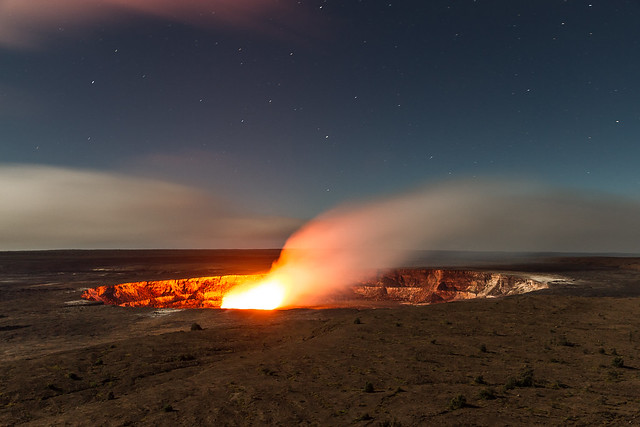An interesting article was recently posted on the Hawaii Tribune Herald site by the Hawaiian Volcano Observatory (HVO) about how scientists are looking to Hawaiian chants for mention of past crater lakes.
The Halema‘uma‘u crater lake at the summit of Kilauea Volcano is on everyone’s mind at the USGS Hawaiian Volcano Observatory (HVO). This is the first lake of groundwater observed on the crater floor in nearly 200 years. So they looked to Hawaiian chants for mention of a crater lake before western contact and whether it was associated with explosive eruptions.
To their knowledge, a lake is not mentioned explicitly, but Hawaiians did tell a few stories where Pelehonuamea faced the threat of water drowning her volcanic fires at Kilauea. A few are briefly recounted here.

Halema‘uma‘u crater, photo from flikr.com
Pele and her older sister Namakaokaha‘i, the eldest in a family of many siblings, were imbued with different powers — Pele reigned over volcanoes and eruptions; Namakaokaha‘i ruled the seas and beaches.
Namaka, as she is known to friends, hated when Pele spread lava over beaches and intruded land into the ocean. Pele didn’t appreciate Namaka trying to remove lava from the coasts. They fought frequently. We see these two sisters continuing to fight with spectacular explosive displays each time lava enters the ocean.
Another Pele story involving water features Kamapua‘a, the pig deity from Oahu, who traveled to Kilauea to woo Pele and take her for his wife. Pele persistently spurned his advances, insulting him and even tried to kill him. Kamapua‘a’s infatuation turned into anger, and the pig-man flooded Pele’s crater with water to put out her volcanic fires.
Fortunately, Pele’s brother hid her firesticks and used them to reignite the volcanic flames. Some versions of this story describe Pele chasing Kamapua‘a to the sea as either a lava flow or ejected hot rocks; other versions resolve the conflict in a brief marriage.
A better-known story is the saga of Hi‘iakaikapoliopele, Pele’s youngest sister. It’s a long story mostly focused on Hi‘iaka’s journey from Kilauea Crater to Kauai to retrieve Pele’s lover, Lohi‘au. Along the way, Hi‘iaka developed into a powerful woman. The journey was long, and Pele became suspicious that Lohi‘au was being unfaithful to her.
When Hi‘iaka arrived at the Kilauea Crater rim with her new husband, Lohi‘au, Pele was incensed and ordered her siblings to kill him as punishment. This enraged Hi‘iaka and she decided to retrieve Lohi‘au’s spirit to revive him, and to seek revenge and destroy Pele by flooding Kilauea Crater with water.
Hi‘iaka jumped down to the crater floor, and not finding the spirit of her husband, stomped her feet. “The entire crater of Kilauea was rocked and the cliff walls of Uekahuna trembled” (from “The Epic Tale of Hi‘iakaikapoliopele” translated by Nogelmeier) and the first layer of Kilauea cracked open. She looked down, but still not seeing her husband, she stomped again. She continued stomping through several layers without finding her husband’s spirit.
The described effects of Hi‘iaka repeatedly stomping to get deeper beneath the crater floor are eerily like the continuous strong shaking of the 2018 collapse events.
Hi‘iaka finally got down to the fifth layer that was holding back water, which, if released, would rise and flood the crater, turning Kilauea into a lake and putting out Pele’s fires forever. At the last instant, Hi‘iaka was dissuaded from her destructive task and reconciled with her sister.

Hi‘iaka was seeking groundwater like that which appears in Halema‘uma‘u today. Geophysical studies over the past 30-40 years showed the presence of a water table, elevated about 600-800 m (2,000-2,600 ft) above sea level, beneath the caldera floor. HVO scientists hypothesize that the currently growing lake is an exposure of this groundwater returning to its former level following the 2018 summit collapse. It is only visible to us because of the deep pit formed by that collapse.
HVO geologists think this Hi‘iaka story may have been inspired by an earlier Kilauea caldera collapse about 1500 CE. Although in most versions of the story Kamapua‘a’s deluge didn’t result in explosions and Hi‘iaka never unleashed subterranean water, geologic study of post-collapse explosive deposits suggests at least an intermittent presence of a lake.
These legends are but a few from the rich Hawaiian literature on Pelehonuamea and her volcanoes. Along with geologic studies, they can provide insight to understanding the ever-changing volcanic landscape of Kilauea Volcano.
